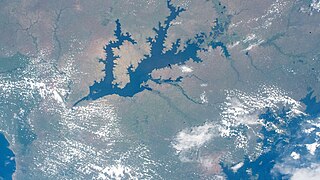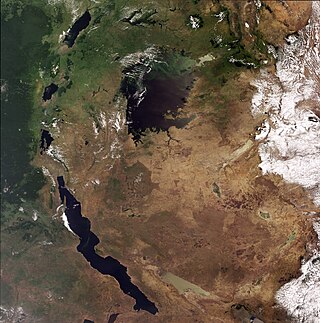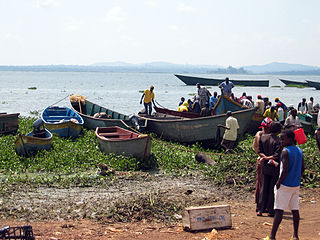
Lake Tana is the largest lake in Ethiopia and a source of the Blue Nile. Located in Amhara Region in the north-western Ethiopian Highlands, the lake is approximately 84 kilometres long and 66 kilometres wide, with a maximum depth of 15 metres, and an elevation of 1,788 metres. Lake Tana is fed by the Gilgel Abay, Reb and Gumara rivers. Its surface area ranges from 3,000 to 3,500 square kilometres, depending on season and rainfall. The lake level has been regulated since the construction of the control weir where the lake discharges into the Blue Nile. This controls the flow to the Blue Nile Falls and hydro-power station.

Uganda is located in Eastern Africa, West of Kenya, South of South Sudan, East of the Democratic Republic of the Congo, and North of Rwanda and Tanzania. While much of its border is on lakeshores, Uganda is landlocked with no access to the sea port but it is a fertile and well-watered country that consists of many lakes and rivers including the largest, Lake Victoria. The country sits in the heart of the Great Lakes region, with Lake Edward, Lake George and Lake Albert on its Western border, Lake Kyoga in the Eastern part of Uganda. It is found in Central Saharan Africa and receives reliable rainfall throughout the year. Rivers are River Nile the longest river in Africa, River Kagera, River Katonga, River Semiliki and River Sezibwa.

Lake Victoria is one of the African Great Lakes. With a surface area of approximately 59,947 km2 (23,146 sq mi), Lake Victoria is Africa's largest lake by area, the world's largest tropical lake, and the world's second-largest fresh water lake by surface area after Lake Superior in North America. In terms of volume, Lake Victoria is the world's ninth-largest continental lake, containing about 2,424 km3 (1.965×109 acre⋅ft) of water. Lake Victoria occupies a shallow depression in Africa. The lake has an average depth of 40 m (130 ft) and a maximum depth of 80–81 m (262–266 ft). Its catchment area covers 169,858 km2 (65,583 sq mi). The lake has a shoreline of 7,142 km (4,438 mi) when digitized at the 1:25,000 level, with islands constituting 3.7% of this length.

The Nile perch, also known as the African snook, Goliath perch, African barramundi, Goliath barramundi, Giant lates or the Victoria perch, is a species of freshwater fish in family Latidae of order Perciformes. It is widespread throughout much of the Afrotropical realm, being native to the Congo, Nile, Senegal, Niger and Lake Chad, Volta, Lake Turkana, and other river basins. It also occurs in the brackish waters of Lake Maryut in Egypt. The Nile perch is a fish of substantial economic and food-security importance in East Africa. Originally described as Labrus niloticus, among the marine wrasses, the species has also been referred to as Centropomus niloticus. Common names include African snook, Victoria perch, and many local names in various African languages, such as the Luo name mbuta or mputa. In Tanzania, it is called sangara, sankara, or chenku. In Francophone African countries, it is known as capitaine. Its name in the Hausa language is giwan ruwa, meaning "water elephant".

Lake Albert, originally known as Lake Mwitanzige by the Banyoro, Nam Ovoyo Bonyo by the Alur, and temporarily as Lake Mobutu Sese Seko, is a lake located in Uganda and the Democratic Republic of the Congo. It is Africa's seventh-largest lake, as well as the second biggest of Uganda's Great Lakes.

Lake Kyoga or Lake Kioga is a large shallow lake in Uganda, about 1,720 km2 (660 sq mi) in area and at an elevation of 1,033 metres. The Victoria Nile flows through the lake on its way from Lake Victoria to Lake Albert. The main inflow from Lake Victoria is regulated by the Nalubaale Power Station in Jinja. Another source of water is the Mount Elgon region on the border between Uganda and Kenya. While Lake Kyoga is part of the African Great Lakes system, it is not itself considered a great lake.

The Sudd is a vast swamp in South Sudan, formed by the White Nile's Baḥr al-Jabal section. The Arabic word sudd is derived from sadd, meaning "barrier" or "obstruction". The term "the sudd" has come to refer to any large solid floating vegetation island or mat. The area which the swamp covers is one of the world's largest wetlands and the largest freshwater wetland in the Nile Basin.

The African Great Lakes are a series of lakes constituting the part of the Rift Valley lakes in and around the East African Rift. The series includes Lake Victoria, the second-largest freshwater lake in the world by area; Lake Tanganyika, the world's second-largest freshwater lake by volume and depth; Lake Malawi, the world's eighth-largest freshwater lake by area; and Lake Turkana, the world's largest permanent desert lake and the world's largest alkaline lake. Collectively, they contain 31,000 km3 (7,400 cu mi) of water, which is more than either Lake Baikal or the North American Great Lakes. This total constitutes about 25% of the planet's unfrozen surface fresh water. The large rift lakes of Africa are the ancient home of great biodiversity, and 10% of the world's fish species live in this region.

Lake Bunyonyi is in south-western Uganda between Kisoro and Kabale, close to the border with Rwanda. The lake appeared from 2004 to 2009 on the USh 5,000/= note under the title "Lake Bunyonyi and terraces". Scientific literature generally quotes a maximum depth of 40 m (130 ft), but some tourist guides and locals insist that it is much deeper, about 900 m (3,000 ft), which would make it the second-deepest lake in Africa.
The silver cyprinid also known as the Lake Victoria sardine, mukene, and omena, dagaa (Swahili) is a species of pelagic, freshwater ray-finned fish in the carp family, Cyprinidae from East Africa. It is the only member of the genus Rastrineobola.

Oreochromis esculentus, the Singida tilapia or Graham's tilapia, is a species of cichlid endemic to the Lake Victoria basin, including some of its satellite lakes such as Kyoga, in Tanzania, Uganda, and Kenya. Its common name refers to Lake Singida, but this population is the result of an introduction that happened in the 1950s. This fish is highly valued by local fishermen, who know it as ngege.

There are two major sources of fish in Uganda; one is from aquaculture, the other from fishing in rivers and lakes. The latter has made up the largest and most significant share of all fishing. Open water covers 15.3 percent of Uganda's surface and comprises five major lakes which are the main sources of fish in the country. Lake Victoria continues to be the most important water body in Uganda both in size and contribution to the total fish catch, followed by Lake Albert and Lake Kyoga.

Lake Nabugabo is a small freshwater lake in Uganda.

Lake Victoria supports Africa's largest inland fishery, with the majority of the catch being the invasive Nile perch, introduced in the Lake in the 1950s.

Lake Bisina, also known as Lake Salisbury and Lake Bisinia, is a freshwater lake in eastern Uganda. It is a satellite lake of Lake Kyoga, which it drains into, and the two are to some extent directly connected by papyrus swamps. During the high-water rainy season, Lake Bisina can be up to 6 m (20 ft) deep and often directly connects with the smaller Lake Opeta, but during the dry season the two are clearly separated.
There are two major sources of fish in Uganda; one is from aquaculture, the other from fishing in rivers and lakes. Different types of fish flourish in different water sources. The waters of Uganda contain an impressive array of fish species—over 90 in all. This count does not include the Haplochromis complex, which itself is made up of more than 200 species.

Fishing gear and methods used in Uganda are both modern and traditional. Fish in Uganda are caught mostly with plank canoes and to a lesser extent, fiberglass boats. Some dugout canoes are also still being used. The plank canoes are generally 4–12 m (13.12–39.37 ft) in length and dugout canoes average 3.5 m (11.48 ft). The total number of vessels is about 17,000 and about 20% of these are motorized. Artisanal fishermen use various gear including gillnets, seines and hook and line. In a number of localities, traditional methods including baskets, traps and mosquito nets continue to be used. The gear commonly used includes gillnets, lift nets, scoop-nets used in light fishing; hook and line gear and fish traps.

Lake Kanyaboli is the largest oxbow lake in Kenya and the second largest in Africa,formed after River Yala disconnected from its course at the meander stage, leaving behind a U-shaped lake. The lake is found in Siaya County in western Kenya and is home to a variety of fish species that have almost disappeared from Lake Victoria, the country's largest freshwater lake.

Lake Nakuwa Wetland System is a wetland found in the south-eastern part of the Kyoga system covering the districts of Kamuli District, Pallisa District and Soroti District in Eastern Uganda. The wetland is located 25 kilometres (16 mi) from Pallisa town. It covers an area of 911.5 km².

Lake Kachera is also known as Lake Kachira, Lake Kacheera, Lake Kakyera and Lake Kachra is a shallow fresh water lake that is located in Rakai district and Mbarara district in Uganda. It is a part of the Mburo-Nakivale wetland system and also a part of the complex system of lakes known as Koki lakes that are separated by vast swamps. It is also one of the lakes that make the Victoria satellite lakes.




















